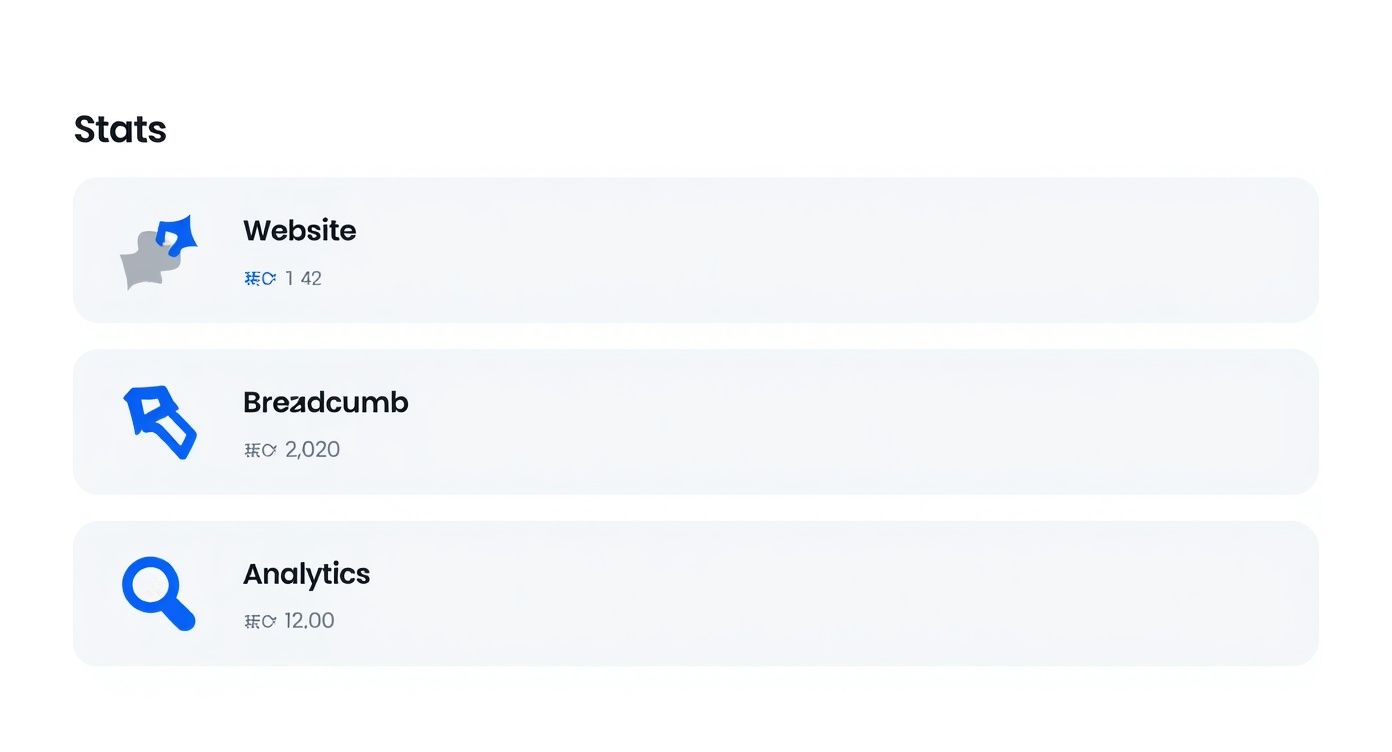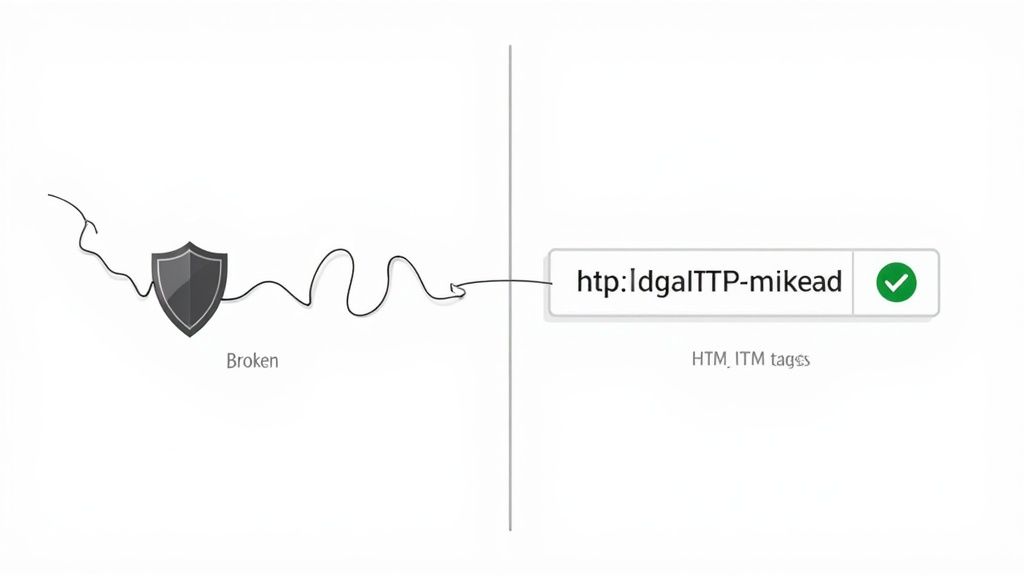- Date
What Is Referral Source and Why Does It Matter?
 Andrii Romasiun
Andrii Romasiun
So, what exactly is a referral source? In simple terms, it's the specific website, social media platform, or online space that directed a visitor to your site. Think of it like a digital word-of-mouth recommendation. When someone clicks a link on another site and lands on yours, their starting point is the referral source.
This single piece of information is a powerful clue, telling you which online relationships and content strategies are actually working to bring people to your digital doorstep.
Unpacking the Meaning of a Referral Source

Let's use an analogy. Picture your website as a popular new shop in a busy city. Some people find you because they looked you up on a map (that's search traffic). Others already know your address and walk straight in (direct traffic).
A referral source is like another local business—say, a coffee shop next door—that puts up a sign saying, "You should check out the awesome shop next door!" and points people your way. When someone comes from that coffee shop, they're "referred traffic," and the coffee shop is the referral source. This data is an absolute goldmine for anyone trying to understand their digital footprint.
Why This Data Is So Important
Knowing your referral sources is about more than just counting clicks. It gives you a clear line of sight into what's effective. You can instantly see:
- Valuable Partnerships: Pinpoint which partner websites, industry blogs, or business directories are sending you the most high-quality, engaged visitors.
- Content Performance: Discover which of your guest posts or off-site articles are truly resonating and driving people to learn more.
- Social Media ROI: Identify which social media channels are actually sending traffic, not just collecting likes and shares.
A strong referral isn't just a click; it's a vote of confidence. Visitors arriving from a trusted source often come with a pre-established level of interest, making them more likely to engage with your content or convert.
This table provides a quick overview of the main categories you'll encounter when analyzing your referral data.
Key Referral Source Categories at a Glance
| Source Type | Description | Common Example |
|---|---|---|
| Social Media | Traffic from posts, profiles, or ads on social platforms. | A user clicks a link in an Instagram bio or a tweet. |
| Partner Websites | Visitors coming from sites you have a direct relationship with. | A click from a "Our Partners" page on a collaborator's site. |
| Online Directories | Clicks from business listings or review sites. | Someone finds your business on Yelp and clicks to your website. |
| Blogs & Publications | Traffic from articles, reviews, or mentions in online media. | A reader clicks a link to your product in a gift guide. |
| Forums & Communities | Clicks from discussions on platforms like Reddit or Quora. | A user follows a recommendation link in a relevant discussion thread. |
By separating referral traffic from other channels, you get a much clearer, more nuanced understanding of how people discover you. For a complete breakdown, check out our guide on different https://swetrix.com/blog/website-traffic-sources. Next, we'll dive into the mechanics of how this information is collected and how it can directly impact your business goals.
How Analytics Tools Uncover Referral Traffic
So, how do analytics platforms actually figure out where your visitors are coming from? Think of them as digital detectives. Their most important clue is a tiny piece of data called the HTTP referrer (yes, it's technically misspelled, but that's the standard!). It’s like a digital breadcrumb a user's browser leaves behind.
When someone clicks a link on, say, CoolBlog.com that leads to your website, their browser sends a message to your server that basically says, "Hey, I just came from CoolBlog.com!" This little note is tucked inside the HTTP referrer header. Analytics tools like Swetrix intercept this message and immediately give CoolBlog.com credit as the referral source.
This all happens in a split second, completely behind the scenes. It's a simple, elegant system that underpins almost all referral tracking.
The Anatomy of a Referral Handshake
The whole process is a quick "handshake" between the site they left, their browser, and your site's server. Here’s a play-by-play of what happens:
- The Click: A visitor is on another website and clicks a link pointing to one of your pages.
- The Message: As their browser gets ready to load your site, it packs the URL of the page they just left into that HTTP referrer header.
- The Reception: Your server gets the request, and your analytics script (like the one from Swetrix) reads the header to see where the visitor came from.
- The Attribution: The tool records that original URL, logs the visit under "Referral," and lists the specific domain as the source.
This sequence is the bedrock of understanding your traffic channels. If you want to get into the nitty-gritty of tracking in general, our guide on how to track visits to a website is a great next step.
When the Breadcrumb Trail Goes Cold
But what happens when that breadcrumb is missing? Sometimes, a visitor shows up with no referrer information at all. In your analytics reports, these mysterious arrivals get lumped into a category called Direct traffic.
Direct traffic represents visitors who arrived on your site without a discernible digital trail. Your analytics tool knows they're here, but it doesn't know how they found you.
This data gap can happen for a few common reasons:
- Someone typed your website address directly into their browser.
- They clicked on a bookmark they'd previously saved.
- The link was clicked from a non-web source, like a document, a desktop email app (like Outlook), or a mobile messaging app.
- Security settings blocked the referrer data. A classic example is when a user clicks a link from a secure HTTPS site to a non-secure HTTP site—the referrer often gets dropped for privacy.
Getting a handle on this distinction is crucial. A referral source tells you a clear story about a visitor's journey, but Direct traffic is more of a black box. A well-tuned tracking setup aims to shrink that black box as much as possible, making sure your marketing efforts get the credit they deserve.
The True Economic Impact of Referral Traffic
So, we've covered the basics of what a referral source is and how your analytics tools track it. But let's move beyond the technical "what" and get into the strategic "why." Referral traffic isn't just another number to glance at in a report; it’s a powerful economic engine that can fuel real, sustainable growth.
Think about it: visitors who arrive through a referral link come with a built-in layer of trust. They didn't just stumble upon your site randomly. Someone or something they already trust sent them your way. That subtle endorsement makes them more qualified, more engaged, and far more likely to take action.
From Clicks to Conversions
The trust a visitor has for the referring site transfers directly to you, acting as a powerful catalyst. A user clicking through from a well-respected industry blog is already in the right frame of mind to see your content or products in a positive light. This "warm" introduction makes the journey from first click to final conversion—whether that’s a sale, a signup, or a demo request—much shorter and smoother.
This isn't just a gut feeling; the financial impact is real and has been measured across different industries.
For many professional services, referrals are their lifeblood. In the consulting world, for instance, a massive 60% of new business comes directly from referrals. Some firms even attribute as much as 95% of their total revenue to these trusted connections. It’s a similar story in the tech world, where top SaaS companies often generate 15-30% of their revenue from referral programs alone. You can dig deeper into how referral networks drive business growth.
This infographic breaks down the simple but powerful journey of a referred visitor, from the moment they click a link to how that data appears in your analytics.

As you can see, every click leaves a digital breadcrumb, which is what allows analytics tools to trace that visitor’s path all the way back to the source.
Cultivating High-Value Traffic
Because they arrive with high intent, referred visitors often show greater loyalty and have a much higher customer lifetime value (CLV). They tend to stick around longer and are more likely to become brand advocates themselves, creating a fantastic, self-sustaining cycle of growth. This is why building up your referral sources should be a core business strategy, not just a passive marketing activity.
By focusing on building relationships that generate high-quality referral traffic, you are investing in a more efficient and profitable customer acquisition channel.
To really capitalize on this, you have to attribute every referral correctly. That includes specialized links, like the ones used in affiliate or partner programs. Properly tracking affiliate links is essential for measuring the true ROI of each partnership and rewarding the collaborators who bring you the most value. When you actively manage these sources, you turn a trickle of passive traffic into a predictable and scalable revenue stream—transforming your analytics dashboard from a simple report into a strategic roadmap for growth.
How Digital Transformation Is Reshaping Referrals
The whole idea of a "referral source" has grown up. It's no longer just a simple link from one blog to another. The way we live online has created a bunch of powerful new channels that drive serious, high-intent traffic, and it's completely changing how we should think about referrals.
What used to be a straightforward digital handshake is now a tangled web of social shares, private messages, and even AI-powered suggestions.
Think about it. A link someone shares in a private WhatsApp group, a recommendation buried in a niche Reddit community, or a quick mention in a viral TikTok video can send a flood of new visitors your way. These aren't just empty clicks, either. They're often highly qualified leads who show up with a built-in layer of trust they inherited from the person or platform that sent them. This big shift means we have to look way beyond traditional backlinks to truly get the full story of our audience's journey.

The Rise of New Referral Engines
The places sending traffic to websites today are more dynamic and diverse than ever before. This new referral landscape is made up of a whole host of platforms that influence people in very different ways.
- Social Media Platforms: It's more than just posts now. We're seeing referrals come from Instagram Stories, exclusive Facebook Groups, and in-depth LinkedIn articles. Each one fosters a unique kind of trust and engagement with its audience.
- Private Messaging Apps: So-called "dark social" channels like Telegram, WhatsApp, and Messenger are huge, often invisible, drivers of traffic. When a link gets shared in a group chat, it's like a powerful personal endorsement.
- Community Forums: Websites like Reddit and Quora have become the modern-day town square. This is where people go for authentic recommendations that guide their decisions.
- AI Discovery Tools: A new kid on the block. Emerging AI assistants and chatbots are becoming a brand-new type of referral source, serving up direct links to users based on their questions.
And this isn't just a gut feeling; the data backs it up. Research from Forrester shows that a massive 65% of referrals now come from mobile messaging apps. On top of that, social media referrals are converting three times better than old-school digital ads. As businesses scramble to keep up, the tech is evolving right alongside them. Gartner even predicts that by 2026, 75% of B2B companies will be using automated systems to track these referrals. You can dig into more stats on the impact of modern referral marketing.
The definition of a referral source has broadened. It's no longer just about which website sent a visitor, but which community, conversation, or influencer sparked their journey.
Getting a handle on this change is absolutely critical. The businesses that figure out how to track, engage, and win over audiences on these varied platforms are the ones setting themselves up for real growth. The key is to see every referral as a signal of trust—it doesn't matter if it came from a formal blogroll or a casual text message. Once you understand that, you can start to see the complete, messy, and fascinating picture of how people really find you online.
Common Referral Tracking Problems and How to Fix Them

Referral sources seem straightforward on paper, but in the real world of web analytics, things get messy fast. A few common technical hiccups can easily skew your data, leading to bad reports and even worse decisions. The first step to getting clean, reliable attribution is understanding where things tend to go wrong.
One of the biggest culprits is what we call "dark social." This is when someone shares a link privately through a text, an email, or a messaging app like WhatsApp. When their friend clicks that link, there's no HTTP referrer to tell your analytics tool where they came from. As a result, the visit gets dumped into the Direct traffic bucket by mistake.
Website security protocols can also cause headaches. If a visitor clicks a link from a secure HTTPS site to a less-secure HTTP one, most browsers will strip the referrer data as a privacy measure. It's a well-intentioned feature, but it creates another black hole in your data, making your Direct traffic numbers look bigger than they actually are.
The Problem of Lost Referrer Data
There are a few other common ways referral data gets lost in transit before it ever hits your analytics dashboard. Knowing these blind spots is crucial if you want to trust your marketing reports.
- App-to-Web Clicks: When someone clicks a link in a desktop app—like Outlook or a project management tool—it often won't pass along any referrer information.
- Redirect Chains: Sometimes, link shorteners or a long chain of redirects can break the connection, losing the original source along the way.
- QR Codes and Offline Links: A user scanning a QR code or clicking a link in a PDF doesn't have a "previous page" in the digital sense, so their visit defaults to Direct traffic.
The core issue here is that you lose the story behind the click. You know someone showed up, but you have no idea why. This makes it impossible to measure the real ROI of your newsletters, social campaigns, or offline marketing.
Taking Control with UTM Parameters
The best way to fight back against these tracking gaps is to manually tag your URLs with UTM parameters. Think of them as little notes you attach to the end of a link that give your analytics platform precise details about a visitor's origin.
A UTM-tagged link sends a clear, unmistakable signal that overrides any missing referrer data. By creating custom links for every campaign, you can make sure every single click is attributed correctly.
Here’s how you can start building them:
- Start with Your Base URL: Grab the clean link to the page you're promoting (e.g.,
https://yourwebsite.com/landing-page). - Add the Campaign Source (
utm_source): Pinpoint the platform or referrer, likeutm_source=monthly_newsletter. - Define the Medium (
utm_medium): Describe the marketing channel you're using, likeutm_medium=email. - Name the Campaign (
utm_campaign): Give it a distinct name you'll recognize, likeutm_campaign=summer_sale_2024.
If you get into the habit of using UTMs for all your marketing links—from social media ads to your email signature—you'll solve most of your referral tracking mysteries. You'll finally get a clear, accurate answer to the question, what is referral source performance really looking like?
Analyzing Your Referral Data in Swetrix
Knowing what a referral source is and how tracking works is one thing. But turning that data into actual growth for your business? That's where the real work begins. With a privacy-focused tool like Swetrix, you can dive into your referral data and make smart decisions without ever compromising your users' privacy.
First things first, you'll want to head over to the "Referrers" report in your Swetrix dashboard. This isn't just a list of links; it’s a ranked breakdown of every single domain sending traffic your way. Think of it as a map of your digital ecosystem, showing you which partnerships, content features, and community shout-outs are actually paying off.
Here’s a glimpse of what that looks like in Swetrix, giving you a clear view of your main traffic drivers.
This snapshot instantly tells you who your top-performing referrers are, highlighting the external sites that are most valuable to your growth.
Digging Deeper Than Just Clicks
Once you've got the report open, it’s easy to fixate on the domains sending the most traffic. That's a decent start, but the game-changing insights come from looking at the quality of that traffic, not just the quantity.
Instead of only asking, "Who sent the most visitors?" start asking better questions:
- Which sources send the most engaged visitors? Check out metrics like bounce rate and average visit duration for each referrer. A source that sends you 50 highly engaged visitors is often far more valuable than one that sends 5,000 who click away instantly.
- Which referrals actually lead to conversions? By setting up custom events in Swetrix, you can see which referral sources are driving valuable actions like newsletter sign-ups, product purchases, or demo requests.
- Are there any surprising new sources popping up? Always keep an eye out for unexpected domains. A new blog post or a mention in a niche forum could be your next big growth opportunity or a new community worth engaging with.
Analyzing referral data isn’t about counting clicks. It's about understanding the story behind them. Each source brings a different audience, a different context, and a different level of intent.
This kind of deeper analysis is what helps you spot your best partnerships, figure out why some channels aren't performing, and uncover new ways to grow—all while putting user privacy first.
Got Questions? We’ve Got Answers
Let's dig into some of the most common questions that pop up around referral sources, direct traffic, and those tricky UTM parameters. Getting these details right is key to truly understanding your traffic.
Referral vs. Direct Traffic: What’s the Real Difference?
Think of referral traffic like a word-of-mouth recommendation. Your analytics tool can see exactly who sent the visitor your way because they followed a specific link, leaving a clear digital trail.
Direct traffic, on the other hand, is a bit of a mystery. This is when someone shows up at your door without a clear referral. They might have typed your website address directly into their browser, used a bookmark they saved ages ago, or clicked a link from a place that hides the origin, like many email apps or a PDF document.
Are Referral Sources and UTM Sources the Same?
Not quite, but they work together. A referral source is what your analytics tool automatically figures out by looking at where the visitor came from. A UTM source is a label you manually add to a link, like utm_source=summer_promo.
You use UTMs when you can't leave tracking to chance. Think email newsletters, social media ads, or QR codes—anywhere the automatic referral data could easily get lost.
Here's the crucial part: if a link has a UTM source tag, it almost always overrides the automatically detected referral source in your reports. This lets you be the ultimate authority on where you say your traffic came from.
How Do I Get More Referral Traffic?
Boosting referral traffic isn't about a single trick; it's about earning your place on the web. It's a long game, but the payoff is huge. Here are a few solid strategies that always work:
- Create "Link-Worthy" Content: Go beyond the basics. Publish original research, create a genuinely helpful tool, or write the most comprehensive guide on a topic. Give people a reason to say, "You have to see this."
- Build Your Network: Don't just exist in your industry—participate in it. Connect with other creators for guest posts, collaborations, or even just to share each other's work. Real relationships lead to real links.
- Show Up in the Right Places: Get your website listed in reputable online directories, on review sites like G2 or Capterra, and in any niche portals your ideal customers might visit.
- Be a Voice in Your Community: Find the forums, Slack channels, or social media groups where your audience hangs out. Offer real help and share your expertise. When it makes sense, you can drop a link back to your site.
Ready to see your referral sources with total clarity, all while respecting user privacy? Swetrix gives you the powerful, simple analytics you've been looking for. Start your 14-day free trial and start turning your traffic data into real-world insights today.